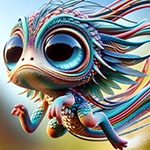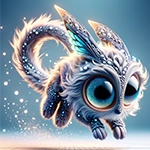Home » Creating images with artificial intelligence
Creating images with artificial intelligence
In the field of modern technology, artificial intelligence (AI) has emerged as a powerful force, capable of performing tasks that were previously reserved solely for human creativity. Among its many applications, artificial intelligence image generation stands out as a remarkable achievement, where machines can create stunning visual content with amazing realism and accuracy. In this article, we will delve into the fascinating world of artificial intelligence image generation and examine the underlying mechanisms, algorithms, and technologies that drive this transformational process.
Behind the Scenes of Artificial Intelligence That Produces Images – How It Really Works
1. GANs – Creative Network of Generators
At the forefront of AI image creation are GANs, two networks of image-generating AI that together produce accurate and realistic images.
How It Works: One network creates synthetic images, while the other network evaluates these images and provides feedback to the generator to improve its output.
Through the learning process, the networks learn to create more and more realistic images, imitating the patterns and features present in the training data.
2. Networks That Mimic the Human Visual System (CNNs)
Convolutional Neural Networks (CNNs) serve as the backbone of artificial intelligence image generation and provide the computational framework for analyzing and processing visual data.
CNNs are designed to mimic the structure of the human visual system, with multiple layers of neurons that extract hierarchical features from images.
These features capture information such as textures, shapes, and colors and allow the artificial intelligence system to understand and manipulate accurate and unusual visual content.
3. Learning and Leveraging the Dataset
In addition to GANs and CNNs, AI leverages both models. By fine-tuning pre-trained models on specific tasks or datasets, AI systems can adjust their learned representations to create new images that display desired characteristics or styles.
This approach speeds up the training process and improves the quality of the generated images, especially in areas where labeled training data is limited.
Also, with the help of the generators, it learns the information about existing images and uses them as a database to create new images. The new images may be somewhat similar in concept to famous images, but they will be different and express a whole database of several images together rather than a single image. This is how artificial intelligence actually creates an original image.
In certain artificial intelligences, when you ask for a certain style of famous painters, the artificial intelligence with the help of its generators will know how to create a different image in the same style.
When will we want to create images with artificial intelligence?
When they say that one picture is worth 1000 words, it’s not just a saying! People would express themselves in drawing and computer graphics all the time and in fact this field belonged only to those who had the professional knowledge.
Today, even those who do not have the professional knowledge can easily use artificial intelligence and create original pictures for themselves for home or business marketing.
And what do those who have the knowledge do? They simply shorten processes and their work has become simpler.
So if you are still debating whether to try? We promise you that once you start, you won’t want to stop, because it’s simply a fascinating world.
It starts as soon as you write the description line for the artificial intelligence and continues with the expectation to see what its product is.
The importance of our request is understood in front of the picture we will receive
The diversity and difference of one image from the other created by the artificial intelligence, depends mainly on your request from it. You can ask her for precise details in several forms of wording and get something completely different and this is actually the secret of creating images with AI.
Also, you can upload a certain image as inspiration and request changes in it such as adding items, missing items, changing colors, changing style, etc. All of these will create one image that is different from the image you uploaded.
The artificial intelligence DALL-E for creating images
One of the most popular programs for creating images is DALL-E. If this name sounds familiar to you, it is not for nothing, because it is the name of the famous painter Dali.
This model of artificial intelligence allows you to write to it the subject of the image you want to produce and it will already create the initial style for you which is usually realistic.
How to use DALL-E correctly?
Go to the text area, write a description of the image you want to receive. Please note, you have a 400 character limit, so think carefully about what you write.
It is very important to indicate in the text that you are writing the style you are interested in, so you will get a much more accurate picture. When finished, send your request and wait for the image to be created.
Once the image is created, you can start requesting changes and upgrades on what the AI has created. In this way, you will create a number of diverse and different images.
To purchase a photo creation package in Dali click here >>
The artificial intelligence Stable Diffusion
This artificial intelligence is based on deep learning that produces an image using text. This is a relatively old artificial intelligence that was published back in 2022.
With the help of this artificial intelligence, you can create detailed photos, you can take existing photos and upgrade them and even change their colors.
What is unique about Stable Diffusion artificial intelligence is that it is accessible and published to the public, so that anyone can use its code and make adjustments.
What can you create with it?
It is about creating artificial intelligence images for free from scratch, that is, from your text only, so even in this case the instructions have meaning.
As with Dali, you will have to describe your request in detail, in order to receive a detailed and accurate picture of your request.



